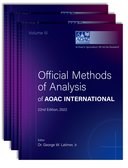 Official Methods of Analysis of AOAC INTERNATIONAL (22nd Edition)
Official Methods of Analysis of AOAC INTERNATIONAL (22nd Edition)
Contents
16.2.06
AOAC Official Method 981.18
Light Filth in Tea: Flotation Method
Get access
-
Published:January 2023
Cite
Light Filth in Tea: Flotation Method', in Dr. George W Latimer, Jr. (ed.), Official Methods of Analysis of AOAC INTERNATIONAL, 22nd Edition (
Extract
First Action 1981
Final Action 1988
Reagents
Sequestering agent.—Mix 50 mL Tween 80–40% isopropanol, 945.75C(x) (see 16.1.01), 50 mL Na4EDTA-40% isopropanol, 945.75C(z) (see 16.1.01), and 200 mL 40% isopropanol.
Determination
Weigh 10 g test portion into 800 mL beaker, add ca 300 mL boiling water, heat to boiling, and simmer 6 min with magnetic stirring using Teflon-coated bar. Wash material from beaker to No. 230 sieve with forcible stream of aerated water, but do not let mixture splash out of sieve. When rinse water is clear, drain residue and quantitatively transfer with 40% isopropanol to 2 L Wildman trap flask. Rinse sides of flask with 40% isopropanol, and bring total volume in flask to 900 mL with 40% isopropanol. Pour 50 mL flotation oil, 945.75C(k) (see 16.1.01), down stirring rod, with top of disk or rubber stirring stopper held just below surface of liquid. Clamp rod above liquid. Magnetically stir 6 min. Let stand 2–3 min. Pour 300 mL sequestering agent down stirring rod, with top of disk or rubber stirring stopper held just below surface of liquid. Mix 1 min by gently swirling with stirring rod beneath surface of liquid. Pour 40% isopropanol slowly down stirring rod to fill flask. Rinse rod with 40% isopropanol and clamp so that stopper is held above layer of settled material. Let stand 5 min. Rotate stopper to free settled material. Let stand 25 min and trap off, rinsing neck with isopropanol until all residue is removed. Rinse neck with 40% isopropanol and add rinse to trappings. Add 30 mL flotation oil by pouring down stirring rod into trap flask. Hand-stir 1 min to bring flotation oil down. Add 40% isopropanol to refill flask. Let stand 30 min, and trap off into same beaker of first trappings. Rinse neck with isopropanol until all residue is removed. Transfer combined trappings onto one or more ruled filter paper(s). Examine paper(s) microscopically at 30× for insect fragments and rodent hairs.
Sign in
Personal account
- Sign in with email/username & password
- Get email alerts
- Save searches
- Purchase content
- Activate your purchase/trial code
- Add your ORCID iD
Purchase
Our books are available by subscription or purchase to libraries and institutions.
Purchasing information| Month: | Total Views: |
|---|---|
| March 2024 | 2 |
| April 2024 | 5 |
| May 2024 | 4 |
| June 2024 | 3 |
| July 2024 | 13 |
| August 2024 | 14 |
| September 2024 | 4 |
| October 2024 | 1 |
| November 2024 | 4 |
| December 2024 | 6 |
| January 2025 | 7 |
| February 2025 | 4 |
| March 2025 | 11 |
| April 2025 | 2 |




Get help with access
Institutional access
Access to content on Oxford Academic is often provided through institutional subscriptions and purchases. If you are a member of an institution with an active account, you may be able to access content in one of the following ways:
IP based access
Typically, access is provided across an institutional network to a range of IP addresses. This authentication occurs automatically, and it is not possible to sign out of an IP authenticated account.
Sign in through your institution
Choose this option to get remote access when outside your institution. Shibboleth/Open Athens technology is used to provide single sign-on between your institution’s website and Oxford Academic.
If your institution is not listed or you cannot sign in to your institution’s website, please contact your librarian or administrator.
Sign in with a library card
Enter your library card number to sign in. If you cannot sign in, please contact your librarian.
Society Members
Society member access to a journal is achieved in one of the following ways:
Sign in through society site
Many societies offer single sign-on between the society website and Oxford Academic. If you see ‘Sign in through society site’ in the sign in pane within a journal:
If you do not have a society account or have forgotten your username or password, please contact your society.
Sign in using a personal account
Some societies use Oxford Academic personal accounts to provide access to their members. See below.
Personal account
A personal account can be used to get email alerts, save searches, purchase content, and activate subscriptions.
Some societies use Oxford Academic personal accounts to provide access to their members.
Viewing your signed in accounts
Click the account icon in the top right to:
Signed in but can't access content
Oxford Academic is home to a wide variety of products. The institutional subscription may not cover the content that you are trying to access. If you believe you should have access to that content, please contact your librarian.
Institutional account management
For librarians and administrators, your personal account also provides access to institutional account management. Here you will find options to view and activate subscriptions, manage institutional settings and access options, access usage statistics, and more.